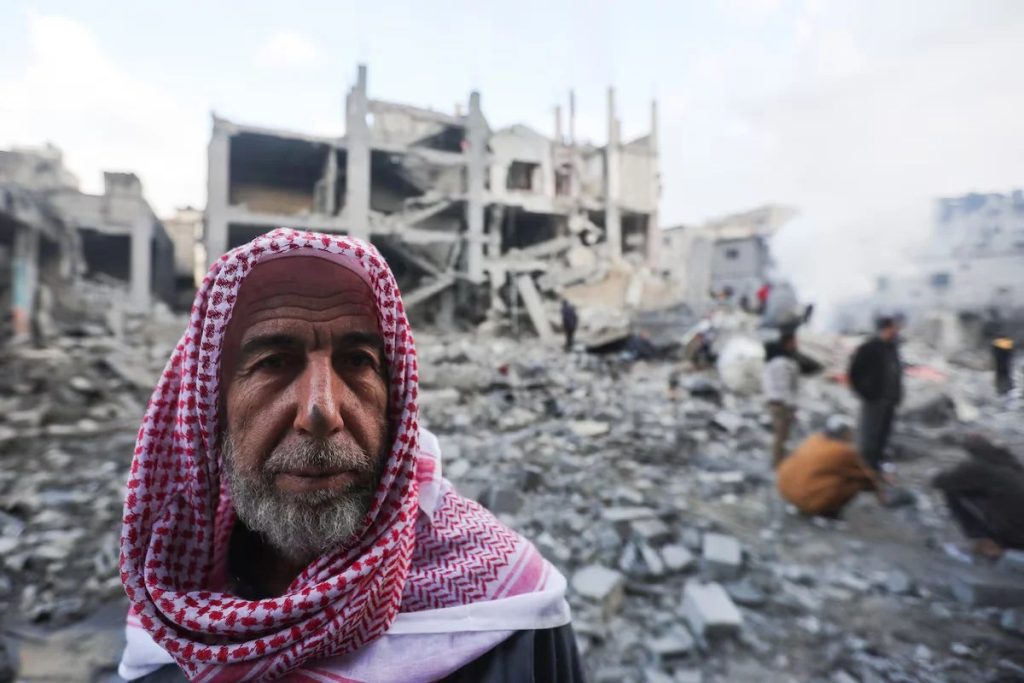The latest Gaza military campaign created a new black record of destruction, tying some of the worst city wars in history. The degree of destruction compares, experts say, with Aleppo destruction in Syria, Mariupol destruction in Ukraine, and even to World War II Allied bombing of Germany. US military historian Robert Pape called the scale “one of the most draconian civilian punishment campaigns in history,” ranking Gaza as one of the most destructive bombardments in all of world history.
Satellite photos reveal whole blocks torn from the face of the Earth—more than two-thirds of Gaza’s north and more than a quarter of Khan Younis leveled to rubble. Homes, mosques, schools, hospitals, and bazaars were rendered splintered wood and concrete, rending asunder the tapestry of daily life.
The scope of the displacement is staggering. From 2.2 million, more than 1.9 million have been displaced from their homes. The Israeli defense evacuation system has been widely decried as useless and pointless, commonly stated amidst communications blockades or after the initiation of real bombardment. In some, safe zones or corridors so asserted were sites of renewed attack. Salah al-Din Road, its intended role being a route for exit, was soon upgraded to the unfortunate designation of “road to death,” punctuated with wrecked vehicles and potholes on the roads.
The humanitarian impact is extreme. Relief officials expect that hunger, exhaustion, and desperation made the population susceptible to collapse. Hospitals across the south are operating several times above intended capacity with rounds of the wounded from the north. There is an official famine in Gaza City, where children are starving and dehydrated. The humanitarian sanctions and blockade have driven the nearly entire population into catastrophic food security, lacking water, medicine, and shelter.
At its heart lies the so-called Dahiya Doctrine, a doctrine of disproportional force in war and deliberate damage to infrastructure to demoralize civilians. First enunciated in past wars, the doctrine was expressed by Israeli General Gadi Eisenkot: “We will use disproportionate force. and inflict huge damage and destruction.” It has been understood in Gaza as leveling entire neighborhoods, power stations, water treatment plants, and hospitals. Human rights groups have characterized the actions as war crimes and collective punishment as intentional targeting of civilians and weaponizing hunger.
Even in its underground form, the war has been remodeled. Hamas has built a hi-tech tunnel complex under cities hundreds of miles long. The Israeli Defense Forces have used specialized units and equipment to locate and bomb the tunnels, but it’s slow, dangerous work that persistently deposits wreckage on the surface above.
Modern War Institute’s John Spencer called it the first time in recent war that an army has ever had to fight mountainous combat both above and below in as thick an atmosphere. Tunnels are exploded using huge explosives, causing twice the destruction to adjacent infrastructure.
Gaza’s civilian infrastructure is very devastated. More than 60 percent of the destroyed houses, and more than 80 percent of commercial properties, are a given estimate. More than 90 percent of the Gaza schools and all the Gaza universities were destroyed or severely damaged as of mid-2024.
The World Health Organization has also documented more than a thousand assaults on healthcare facilities, and the United Nations Environment Programme has sounded an alarm over irreversible damage to water, terrestrial, and marine ecosystems. There even exist cities with no functional hospital anymore.
Global legal institutions have responded. The International Criminal Court has issued warrants for top Israeli commanders on war crimes and crimes against humanity charges for conducting acts such as weaponizing hunger and targeting civilian populations. The International Court of Justice has enforced the Court’s consistent appeals to the restoration of basic services and humanitarian access, but this is only partial, and crossing points remain closed.
This Gaza war shall prove to be one of the worst in the postmodern period. Its trace is not so much in flattened on the ground and mass displacement but in calls for accountability and the relentless insistence of civilians to reclaim their homes and rebuild their broken lives.


